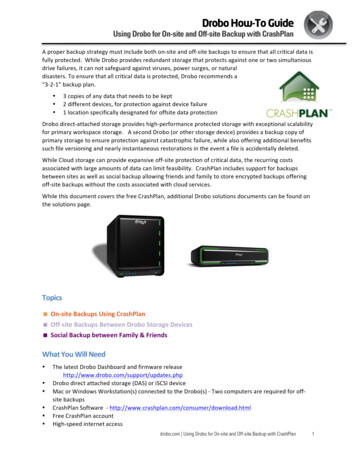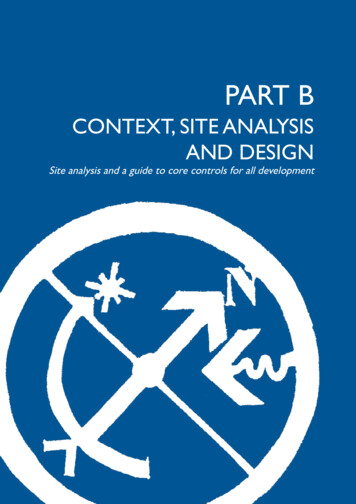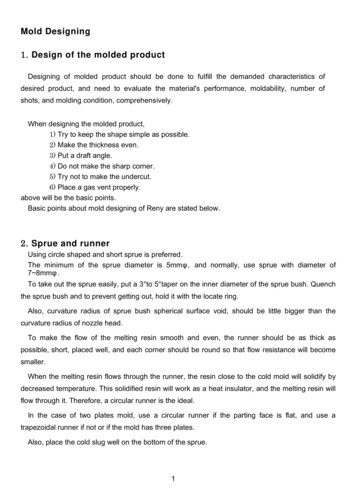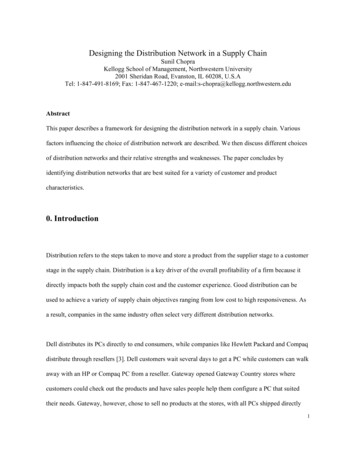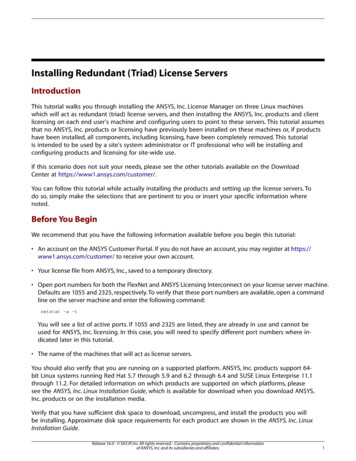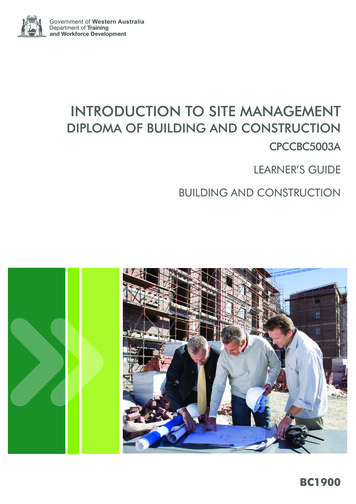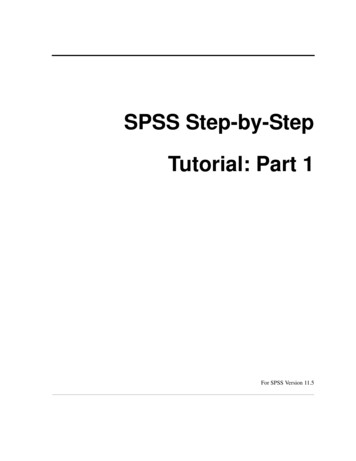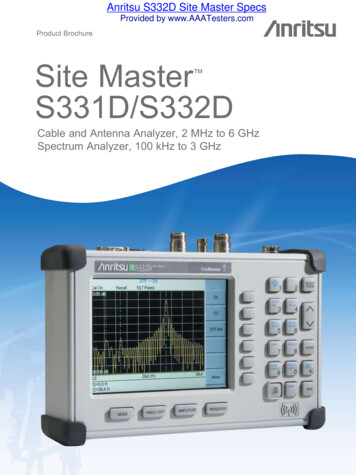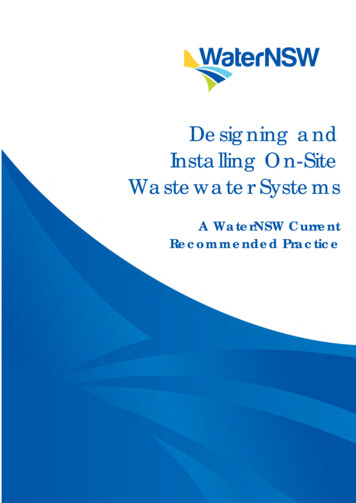
Transcription
Designing andInstalling On-SiteWastewater SystemsA WaterNSW CurrentRecommended Practice
Document ControlVersionDateDocument AdministratorPeer Review DraftJune 2010Planning and Assessments, SCAIndustry Review DraftMay 2011Planning and Assessments, SCAPublication v.1May 2012Planning and Assessments, SCAPublication v.2(Peer reviewed)November 2019Catchment Protection, WaterNSWAcknowledgements‘Designing and Installing On-site Wastewater Systems’ (the Manual) wasdeveloped by WaterNSW with contributions by Joe Whitehead of Whitehead &Associates Environmental Consultants Pty Ltd and Kerry Flanagan of KerryFlanagan Wastewater.DisclaimerThis document includes information about undertaking or assessing adevelopment in the Sydney drinking water catchment. The informationcontained in this document is based on WaterNSW knowledge andunderstanding at the time of writing (August 2019) and should not beconsidered as error free or to include all relevant information.WaterNSW tries to ensure that the information contained in this document isaccurate, adequate and complete. WaterNSW does not make or give anyrepresentation or warrant its accuracy, adequacy or completeness, andrecommends that users exercise their own skill and care with respect to its use.To the extent permitted by law, WaterNSW excludes any liability, including anyliability for any negligence, breach of contract or statutory duty or any failure orthe consequences of that failure in relation to the use of the informationdisclosed in this document.Copyright NoteCopyright in this document is owned by WaterNSW. WaterNSW owns all thepresent and future intellectual property in all the materials authored by it.Subjected to the above, you may photocopy, distribute and otherwise freelydeal with this publication for any purpose, provided that you attribute theinformation to WaterNSW, and you do not alter it in any way.i
Table of Contents1. Introduction . 21.1This Manual .31.2Using this Manual with other guidelines, standards and tools .41.3Technical issues and problems with effluent management.51.4Designer and installer – improving practice and communication 51.5How to use this Manual .72. Site Suitability Assessment and System Selection . 92.1Assessing the wastewater management site .92.2Wastewater standards and WaterNSW requirements . 112.3Selecting a system .182.4System location .222.6Case study .283. Septic Tanks . 294. Aerated Wastewater Treatment Systems . 475. Biological Filter System. 676. Composting Toilets . 857. Greywater Treatment Systems . 958. Amended Soil Mounds . 1059. Sand Mounds . 11710. Absorption Trenches and Beds . 13111. Evapotranspiration Absorption Beds . 15812. Surface Irrigation. 17213. Subsurface and Subsoil Irrigation . 18814. Supplementary Technology . 21014.1Treatment Wetlands .21014.3Membrane systems .21014.4Textile filter systems.21014.5Sand filters.21114.6Subsurface Media Treatment Systems . 21114.7Buffering / balance tanks .21114.8Dosing mechanisms .21215. Acronyms . 21716. Glossary . 21817. References and Further Reading. 223ii
Appendix 1 . 226Appendix 2 . 228Appendix 3 . 231Appendix 4 . 236iii
Designing and Installing On-site Wastewater SystemsDESIGNING AND INSTALLINGON-SITE WASTEWATER SYSTEMSMany on-site wastewater systems installed in the Sydney drinking watercatchment have failed from the day they began operating. WaterNSWrecognises the common failure of systems in the Sydney drinking watercatchment is partly due to the lack of readily available technical informationabout installations. This Manual provides technical installation details notincluded in other guidelines or documents on domestic wastewatermanagement. It brings together detailed design aspects of a variety ofcommon effluent disposal systems and emerging technology. It provideschecklists and standard drawings for approving authorities, system installers andowners. All information in the Manual relates to the Sydney drinking watercatchment but may have a wider benefit elsewhere in NSW.1
Designing and Installing On-site Wastewater Systems1. IntroductionThe Sydney drinking water catchment covers approximately 16,000 squarekilometres and supplies drinking water to over five million people in Sydney, theBlue Mountains, the Illawarra and the Southern Highlands (Figure 1.1).Figure 1.1 Map of the Sydney drinking water catchment2
Designing and Installing On-site Wastewater SystemsThere are more than 11,000 on-site wastewater systems in the catchment across15 local government areas. A range of common technical and design faultsencountered when installing on-site wastewater systems can lead to health andwater quality risks. Under State Environmental Planning Policy (Sydney DrinkingWater Catchment) 2011 (the SDWC SEPP), any development in the catchmentthat requires consent from council, including any on-site wastewater system1,must have a neutral or beneficial effect on water quality (NorBE). This Manualwill help meet the requirements of the SDWC SEPP as they apply to on-sitewastewater systems.On-site wastewater systems are designed according to ‘AS/NZS 1547:2012 Onsite domestic wastewater management’ and the Department of LocalGovernment’s ‘Environment & Health Protection Guidelines: On-site SewageManagement for Single Households’ (the ‘Silver Book’, Department of LocalGovernment, 1998). However, these publications do not provide detailed andcomplete advice about properly installing on-site systems. As a result, designsare often inadequate, and/or their objectives fail due to poor installation. Whenthese systems fail they present a risk to water quality and human health.1.1 This ManualThis Manual will help system installers, design consultants, property owners,council officers, WaterNSW officers, plumbers and contractors to ensure bestpractice methods are used to design and install on-site wastewater systems inthe Sydney drinking water catchment. It is a technical Manual for design andconstruction that brings together and builds on existing documents about onsite wastewater and plumbing.The Manual gives practical and appropriate solutions for specific site constraintsfor the more common types of systems found in the catchment, and somesupplementary technologies. Illustrated case studies and examplesdemonstrate common issues and suggest mitigation measures to minimise therisk of failure. There are annotated Standard Drawings, numerous tables, andchecklists to assist with design, installation, construction and assessment ofvarious systems, emphasising sound hydraulic design.The Manual does not extensively cover choosing the size or type of system. Thischoice must be made according to ‘AS/NZS 1547:2012 On-site domesticwastewater management’ and the Department of Local Government’s‘Environment & Health Protection Guidelines: On-site Sewage Management forSingle Households’ (the ‘Silver Book’). Section 2 of the Manual does describehow to interpret these documents together with WaterNSW’s requirements.The Manual provides recommendations to design, install, test, operate andinspect the following wastewater treatment and effluent disposal systems: septic tanks aerated wastewater treatment systems biological filter systemsNote: Notwithstanding that modifications to existing or installation of a new on-site wastewatersystem under section 68 of the Local Government Act 1993 not requiring consent are notrequired to have a neutral or beneficial effect on water quality, councils and consultants shouldensure that all modifications and installations are consistent with the intent of the SDWC SEPPand this Manual.13
Designing and Installing On-site Wastewater Systems composting toiletsamended soil moundsWisconsin sand moundsgreywater treatment systemsabsorption trenches and bedsevapotranspiration absorption bedssurface irrigation systemssubsurface irrigation systems.The Manual identifies and describes practical approaches and solutions to keyissues. Detailed, annotated Standard Drawings are provided to help the design,installation and inspection of various systems and land application options.Checklists are also provided to help designers, installers and regulators checkthat necessary information is collated and key tasks are completed at differentstages. The checklists are extensive and may include items not relevant to aparticular installation. They can be modified to suit individual needs.1.2 Using this Manual with other guidelines, standards and toolsUnder the SDWC SEPP, new developments should incorporate currentrecommended practices (CRP) or performance standards endorsed byWaterNSW as best practice to help achieve a neutral or beneficial effect onwater quality (NorBE). This Manual is a current recommended practice (CRP),and supplements other existing guidelines and standards (AS/NZS 1547:2012)and the ‘Silver Book’ (Department of Local Government, 1998) for on-sitewastewater management.CRPs and standards are also discussed in the ‘Neutral or Beneficial Effect onWater Quality Assessment Guideline 2015’ (the NorBE Guideline, WaterNSW,2015). The NorBE Guideline helps regulatory authorities decide if a proposeddevelopment has a NorBE.The brochure ‘Developments in the Sydney Drinking Water Catchment – WaterQuality Information Requirements’ (WaterNSW, 2018a; available atwww.waternsw.com.au) is a performance standard developed by WaterNSW.This Manual should be read together with AS/NZS 1547:2012, the ‘Silver Book’and the water quality information requirements brochure.The wastewater effluent model (WEM) is a GIS-based, effluent plume generationmodelling tool used to evaluate on-site wastewater systems designed using theabove documents. The WEM is used to help decide whether NorBE is satisfiedfor developments where on-site wastewater management is required. It allowsa visual interpretation and assessment of the potential impact of an on-sitewastewater system on water quality.The WEM considers site and soil characteristics such as soil depth, permeability,phosphorus sorption capacity, slope and the proposed effluent managementarea. If the WEM shows the effluent plume reaches a watercourse, waterbodyor drainage depression or leaving the boundaries of the site, then NorBE is notsatisfied for the proposal. Wastewater management must be revised, includingpossibly relocating the effluent management area. If no alternative wastewatermanagement solution is possible on the site, then consent must be refused.4
Designing and Installing On-site Wastewater SystemsUsing this Manual should help ensure that an on-site wastewater system that hasbeen designed to achieve NorBE is installed correctly and maintained tocontinue to achieve NorBE throughout the system’s life.1.3 Technical issues and problems with effluent managementA wide range of technical issues and problems have been identified for on-siteeffluent management. They range from simple installation mistakes, such as notsecuring a tank into the ground, to larger design issues, such as havinginsufficient pump head capacity to adequately irrigate a large effluentapplication area. These issues are identified in the section for each system,however, some are common to a range of systems.All systems should be installed according to NSW Workplace Safety requirementsand ‘AS/NZS 3500 (Parts 0-4):2018 Plumbing and drainage Set’.1.4 Designer and installer – improving practice and communicationThis Manual requires system designers to accept more accountability for thedesign, and improved communication between the designer and installer.More accountability for the design is achieved through a Design ProducerStatement, in which the designer warrants the design. Better communicationbetween the designer and installer is achieved by the designer preparing aSystem Design that communicates critical details of the proposed system to theinstaller. It describes and quantifies the design and illustrates the appropriatelayout and configuration of the system with appropriate plans and sketches, aswell as a hydraulic design. For example, it should include a construction drawingto specify the location(s) of the effluent disposal field(s). Appendices 2 and 3include examples of a Design Producer Statement and System Design.The last stage of this process includes submitting an Installation Certificateprovided by the installer. This certifies that the system was installed according tothe System Design. Appendix 4 includes an example of an InstallationCertificate. A copy of the Installation Certificate(s) must be provided to counciland the system designer. The council certifier will make a final inspection beforethe system is approved for use.NOTES The wastewater treatment system and effluent management systemmust be installed by a contractor(s) licensed by NSW Fair Trading. Thatcould be a licensed plumber or a licensed irrigation contractor (or both),each with at least three years’ experience in effluent disposal. The designer must have appropriate professional indemnity insurance forthe system design.Figure 1.2 shows the design and communication process. These documentsclearly allocate the responsibility for the design and installation to the designerand licensed contractor(s) respectively. They provide a higher level ofconfidence for homeowners and regulators that the standards of design andinstallation are appropriately high.5
Designing and Installing On-site Wastewater SystemsClient commissions wastewater consultant toprepare a System DesignWastewater consultant undertakes a site andsoil investigation and, after discussion, asystem is chosenThe wastewater consultant prepares a SystemDesign including wastewater effluent modelNote: it may be necessary to seek prelodgement advice from WaterNSW forcomplex wastewater systems.The System Design accompanies theDevelopment Application for the dwellingCouncil (and possibly WaterNSW) reviews theSystem Design and prepares Conditions ofConsentAt the construction stage the clientcompletes an Application to install theapproved systemIf changes are proposed, a Modification ofconsent may be required – (s4.55 of theEnvironmental Planning and Assessment Act1979) will accompany that application (ifchanges to the approved design are required).Any changes must be approved by the CouncilThe approved treatment system is installed bya licensed plumber and the approved landapplication system is installed by a licensedcontractor with at least three years’experienceThe plumber and the land applicationinstaller (if different) submit their installationcertificates to the system designer and theCouncilFinal inspection of system by CouncilThe client enters into a maintenance contractwith an approved contractor (for all systems)and the system begins operationFigure 1.2 Flowchart to design and install an on-site wastewater system6
Designing and Installing On-site Wastewater Systems1.5 How to use this ManualFor all systems, designers, installers and regulators should first consider theinformation in Section 2 of this Manual that outlines the land capabilityassessment that must be completed for each site. When the assessment isfinished and a suitable system is chosen, Sections 3 to 7 and Section 14 are usedto produce the treatment system design. Each system type has various designelements to consider when installing, commissioning and operating the system.They should be used, where appropriate, to prevent common technicalproblems that can cause the system to fail.Table 1.1 lists each treatment system and land application option in this Manual.Users can select these from the directory and then refer to the appropriatecolour-coded pages for detailed guidance on installing, testing, operating andinspecting the system.Each section includes: information about constructing and installing treatment systems and landapplication methods for effluent management case studies annotated Standard Drawings checklists for installers and regulators.7
Designing and Installing On-site Wastewater SystemsTable 1.1 Quick reference table based on treatment system and land application system typesSelect Treatment System TypeSection 3Septic Tanks(including pump wells)Section 4Aerated Wastewater Treatment Systems(AWTS)Section 5Biological Filter Systems(including wet composting systems)Section 6Dry Composting Systems / ToiletsSection 7Greywater Treatment SystemsSection 14Supplementary TechnologiesSystemChecklist Nos3.13.24.14.25.15.26.16.27.17.2-Select Effluent Management MethodChecklist NosRefer to Standard Drawing NosSection 8 Amended Soil Mounds8.1, 8.28ASection 9 Sand Mounds9.1, 9.29A, 9BSection 10 Absorption Trenches and Beds (gravity and pressure dosed)10.1, 10.210A, 10B, 10C, 10DSection 11 Evapotranspiration Absorption Beds11.1, 11.211A, 11BSection 8 Amended Soil Mounds8.1, 8.28ASection 9 Sand Mounds9.1, 9.29A, 9BSection 10 Absorption Trenches and Beds (gravity and pressure dosed)10.1, 10.210A, 10B, 10C, 10DSection 11 Evapotranspiration Absorption Beds11.1, 11.211A, 11BSection 12 Surface Irrigation12.1, 12.212A, 12B, 12CSection 13 Subsurface and Subsoil Irrigation13.1, 13.213A, 13B, 13CSection 8 Amended Soil Mounds8.1, 8.28ASection 9 Sand Mounds9.1, 9.29A, 9BSection 10 Absorption Trenches and Beds (gravity and pressure dosed)10.1, 10.210A, 10B, 10C, 10DSection 11 Evapotranspiration Absorption Beds11.1, 11.211A, 11BSection 13 Subsoil Irrigation13.1, 13.213A, 13B, 13CSection 10 Absorption Trenches and Beds (gravity and pressure dosed)10.1, 10.210A, 10B, 10C, 10DSection 11 Evapotranspiration Absorption Beds11.1, 11.211A, 11BSection 10 Absorption Trenches and Beds (gravity and pressure dosed)10.1, 10.210A, 10B, 10C, 10DSection 11 Evapotranspiration Absorption Beds11.1, 11.211A, 11BSection 13 Subsoil Irrigation13.1, 13.213A, 13B, 13C--Various technologies to assist in effluent disposal8
Designing and Installing On-site Wastewater Systems2.Site Suitability Assessment and System Selection2.1 Assessing the wastewater management siteAn experienced and appropriately qualified consultant must complete a siteassessment for wastewater management describing the results of a site and soilassessment. WaterNSW’s document ‘Using a Consultant to Prepare Your WaterCycle Management Study’ (WaterNSW, 2018b) contains information aboutchoosing and using a consultant to help prepare a water cycle managementstudy, which includes a wastewater report. The wastewater report will identifythe capability of the site to sustainably manage treated wastewater. Afterdiscussion with the property owner the assessment must recommend aparticular combination of a treatment system and land application method. Thisinformation must be provided in an on-site wastewater report and submitted aspart of the development application.The wastewater report must include: specific details of the proposed wastewater treatment and effluentmanagement method applied for, including the proposed site of theeffluent management area - the wastewater report must recommend aspecific system and effluent management area (EMA), not a range ofoptions a description of how appropriate the proposed system is for thefrequency of use, available power, slope, soils, wastewater load andother site constraints as specified below a site map showing site constraints and the location of the proposedwastewater treatment system and effluent management area relative tokey constraints and buffers consideration of the physical practicality of a proposed gravity-fedsystem given the site slope and grade and whether a pump well isrequired.Appendix 2 of the ‘Environment & Health Protection Guidelines: On-site SewageManagement for Single Households’ (the ‘Silver Book’, Department of LocalGovernment, 1998) includes a template for wastewater reports. The reportshould also refer to current references and standards including ‘AS/NZS1547:2012 On-site domestic wastewater management’ and WaterNSW’s‘Developments in the Sydney Drinking Water Catchment – Water QualityInformation Requirements’.In most cases this Manual provides the standard for design and installation ofon-site wastewater and effluent management systems. WaterNSW’s‘Developments in the Sydney Drinking Water Catchment – Water QualityInformation Requirements’ document indicates which other currentrecommended practice or performance standard to use where appropriate.Site constraints mapThe wastewater report must include a site map identifying all surface constraints,including: the drainage network, including watercourses, drainage depressions anddams, roadside and other open drains (that are treated the same as9
Designing and Installing On-site Wastewater Systems drainage depressions) – in unsewered village areas that are highlyconstrained, this may need to be discussed with WaterNSW and councilvegetation and shading/exposureorientationany poor drainage/wet seepage areas and springsriver flats/ floodplains or flood planning levelany existing or proposed groundwater bores located within 100 metres ofthe effluent management area and their useexisting wastewater management structures and effluent managementareas and whether they are to be retained or decommissionedslope (percentage or degrees)general landformareas of run-onrock outcrop and geologystormwater management structuresall existing and proposed structures including buildings, access ways orroads, livestock yardsbuffer distances (see Table 2.6)exposed soil/erosion potential/fill.Soil informationThe wastewater report must include soil profiles of up to at least one metre or600 millimetres below the base of the proposed land application system(whichever is deeper) taken at the specific locations of the proposed effluentmanagement areas, consistent with AS/NZS 1547:2012. Photos of any soil coreprofiles and the proposed EMA must also be included. The report must describe: soil texture and structure with depth using standard soil descriptions asper AS/NZS 1547:2012 - weathered and decomposing rock of the CHorizon is not considered part of the soil profile when considering effluentdisposal dispersibility (soil with an Emerson aggregate test class 1 are not generallysuitable for effluent disposal (van de Graaff and Patterson, 2001)) other relevant chemical or physical characteristics that could impact onsustainable effluent disposal – e.g. impeded drainage, as identified in the‘Silver Book’ or AS/NZS 1547:2012.The report should also include: electrical conductivity/salinity (soil with more than 8 dS/m are not suitablefor effluent disposal unless the soil is treated) sodicity (soils with more than 10% exchangeable sodium percentage arenot suitable for effluent disposal unless the soil is treated) weighted phosphorus sorption values for the soil profile monthly rainfall and evaporation data.Published soil data is broad scale and must be confirmed with site specific soiltesting.Climate informationRainfall and evaporation data for the site and its implications for the nature andsize of the effluent management area must be considered. This information isavailable in Figure 2.1 and Tables 2.1 and 2.2 of this Manual.10
Designing and Installing On-site Wastewater SystemsWhere relevant, the impact of severe and prolonged frost should also beconsidered when choosing an effluent disposal system e.g. surface irrigationmay not be suitable during winter.2.2 Wastewater standards and WaterNSW requirementsOn-site wastewater systems should be designed according to AS/NZS 1547:2012and the ‘Silver Book’. These documents include appropriate specifications todesign and manage on-site wastewater systems. However, they must beapplied together with WaterNSW’s specific requirements for nutrient and waterbalances, wastewater design loading rates and buffer distances.Nutrient and hydraulic balancesNutrient and hydraulic balances must be used for effluent management areasizing and wet weather storage to ensure a sound design for on-site effluentmanagement. Rainfall and evaporation rates vary widely in the Sydney drinkingwater catchment. An important part of system design is ensuring that rainfalland effluent loads do not exceed the evapotranspiration rate and absorptivecapacity of the soil, and ensuring that the vegetation and soil can readilyassimilate the nutrients in the treated wastewater.Hydraulic balances for effluent irrigation should be calculated as per Appendix6 of the ‘Silver Book’ using design irrigation rate data for the soil from Table M1of AS/NZS 1547:2012. WaterNSW can provide rainfall and evaporation data forvarious geographic zones (Figure 2.1) to help calculate the hydraulic balance.11
Designing and Installing On-site Wastewater SystemsFigure 2.1 Map of catchment evaporation zones and rainfall stationsTable 2.1 Catchment evaporation zone data (Source: SILO)ZoneEvaporation 73123444497399134157195138812
Designing and Installing On-site Wastewater SystemsTable 2.2 Mean rainfall (Source: BOM)Mean Rainfall alAverageLidsdale108.585.271.25966.274.352.265.8 .663.4 58.967.770.076.1861.8Little Hartley84.277.970.659.453.867.261.451.7 45.158.859.272.6762Katoomba161.9175168.6 121.3118.9 81.878.7 71.191.8 108.8 122.41401.9Oberon (JenolanCaves)93.293.5807263.586.680.382.8 6.288.8 71.687.183.674.61007Oakdale102.2 126.6 111.275.748.684.23244.1 43.674.896.777.1890.7124.3 81.172.750.76735.250.5 44.361.990.277.2853.4StationBuxton9199Taralga PO72.769.86758.658.87666.367.4 .345.249.9 49.645.7 46.760.360.362.1710.3Goulburn 6Springfield64.162.157.647.646.554.146.350.7 2.145.1 45.954.857.960.2660.1Lake Bathurst67.159.457.950.845.955.74551.8 52.566.264.860682.1Cataract Dam93.7 115.7 108.899.297.2 112.5 75.870.4 55.477.678.677.61065.3High Range83.381.169.162.648.148.7 47.164.973.574.4816.8Wingello112.5 131.5 100.580.296.6 119.1 60.365.3 9.866.156.8 5.361.6 55.871.692.478.6931.7Moss Vale88.396.39280.582.1 101.4 270.262779.4Bundanoon110.4 122.3 119.194.997.4 113.1 77.974.2 67.688.781.494.11155.6Burrawang112.8 121.9 125.5 132.7 128.4164133.997.3 82.388.183.2 101.71377.4Robertson149.2 166.4 193.5 152.2 138.6187123.6 110.8 92.2 117.6 110.3 120.81675.2Wattamolla131.3 184.6 182.4 136.3 115.9 163.7Kangaroo Valley109.2 133.4 130.6 113.6 109.6 149.6 81.988.5 78.199.5Mt Fairy64.859.762.451.754.263.554.150.7 55.462.4Nerriga67.765.573.655.959.572.160.655.4 ajors Creek89.5 103.7 nglo92.468.467.243.38148105.2 86.5 104.1 769.161.863.465719.279.677.673.7944.548.5 51.166.774.771.779462.1 65.869.982.192.2916.3It is more important to include wet weather storage in hydraulic balance designsin wet areas where the average annual rainfall is more than 1,200 millimetres.Where a proposed effluent irrigation area has separate locations and/ordifferent elev
practice methods are used design and install to on-site wastewater systems in the Sydney drinking water catchment. It is a technical Manual for design and construction that brings together and builds on existing documents
